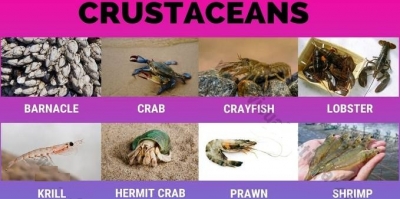
CRUSTACEANS
This varied group of invertebrates includes around 67,000 known species. Crustaceans take their name from the hard, jointed shells, or exoskeletons, that support and protect their bodies. Most crustaceans live in the sea, or in freshwater lakes and rivers, but woodlice and some species of crab live permanently on land. Crustaceans have at least four pairs of jointed legs, gills for breathing underwater, and sensory antennae that they use to feel and smell the things around them.
- CRAB Armed with a pair of powerful claws, and protected by a thick shell, a crab is built for both attack and defence. Crabs can creep forwards very slowly, but they prefer to scuttle sideways because they can move much quicker that way.
- BARNACLE Young barnacles drift in the water like shrimps, but when they become adults they cement themselves to rocks, piers, and even other crustaceans. They feed by extending feathery legs from their shells to catch tiny floating creatures.
- LANGOUSTINE Found in the Atlantic Ocean and North Sea, langoustines are also known as Norway lobsters. They come out at night from their sea-floor burrows to feed on worms and smaller crustaceans. Their muscular tails are eaten as “scampi”.
- LOBSTER Weighed down by their heavy shells, lobsters usually walk on the sea floor, but they can swim backwards to escape danger by flipping their tails. Like all crustaceans, they have to moult (shed) their hard exoskeletons several times as they grow.
- WOODLOUSE Woodlice are among the only crustaceans that are completely at home on land, but they must live in damp places. They have seven pairs of legs and some species can roll themselves into a ball if they feel threatened. Despite their name, they do not damage wood.
- PRAWN Many prawns and shrimps swim or drift in the water, but other spend most of their lives searching for food on the sea bed. Some specialize in picking bloodsucking parasites off the fish that live on reefs, which queue to be cleaned up.
Picture Credit : Google




